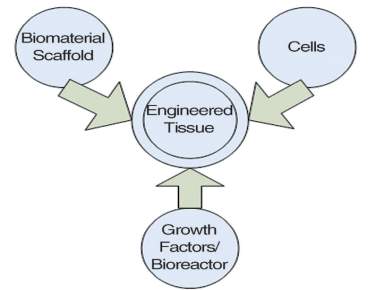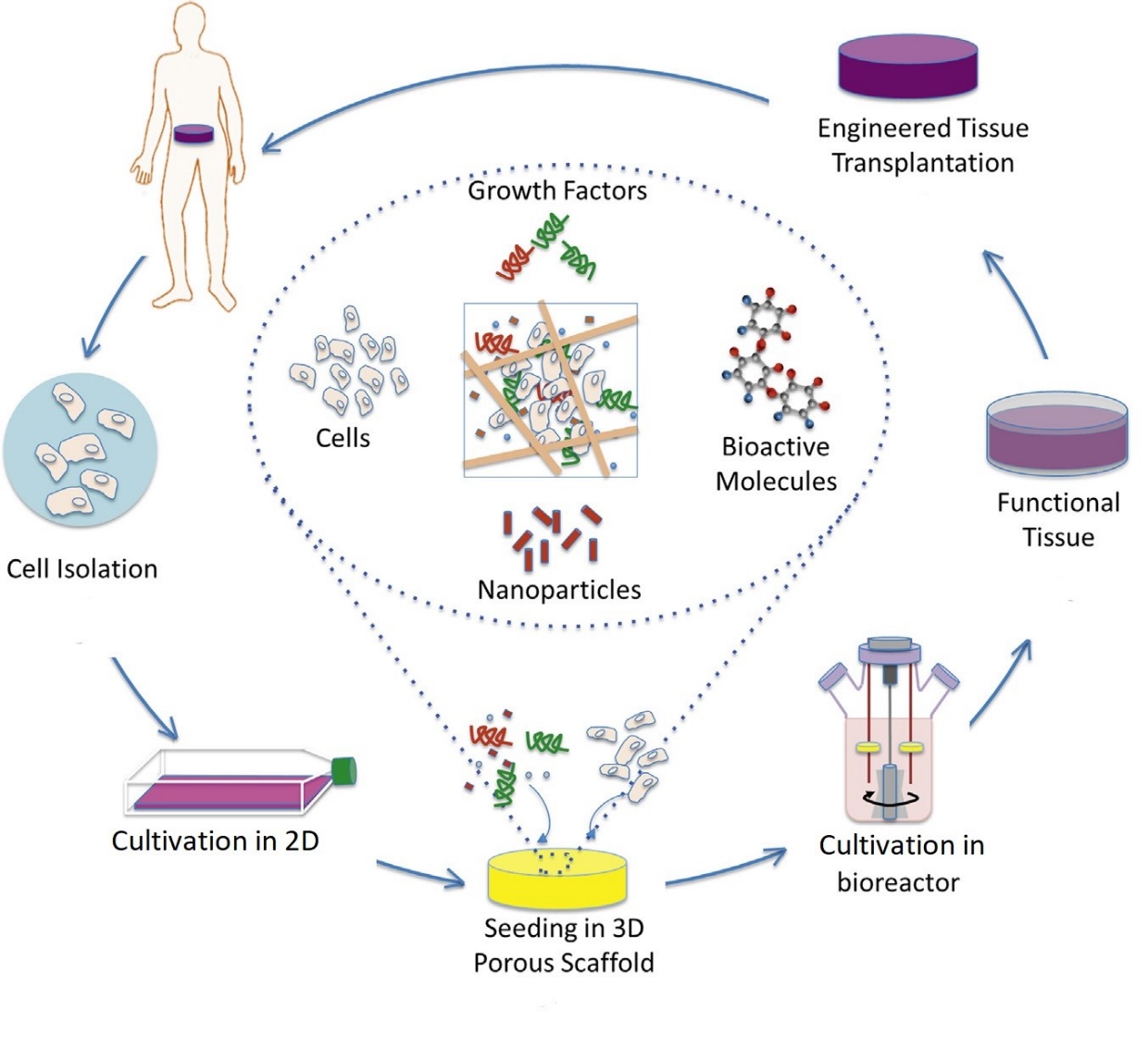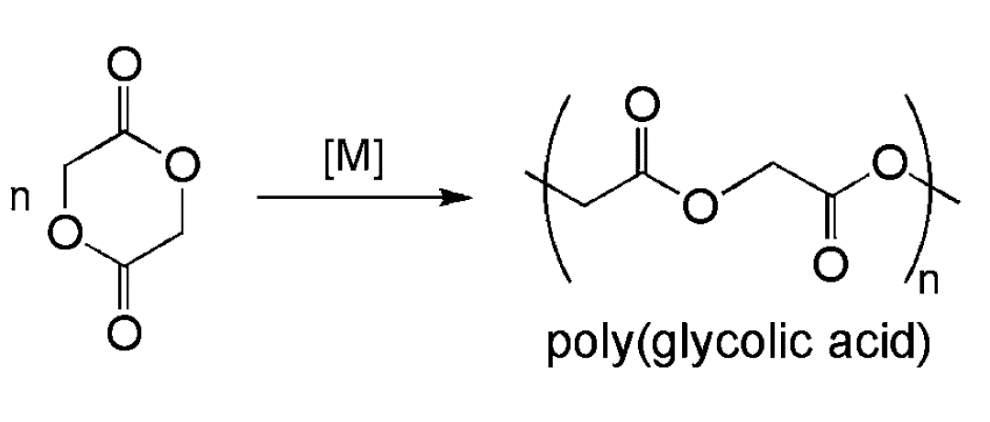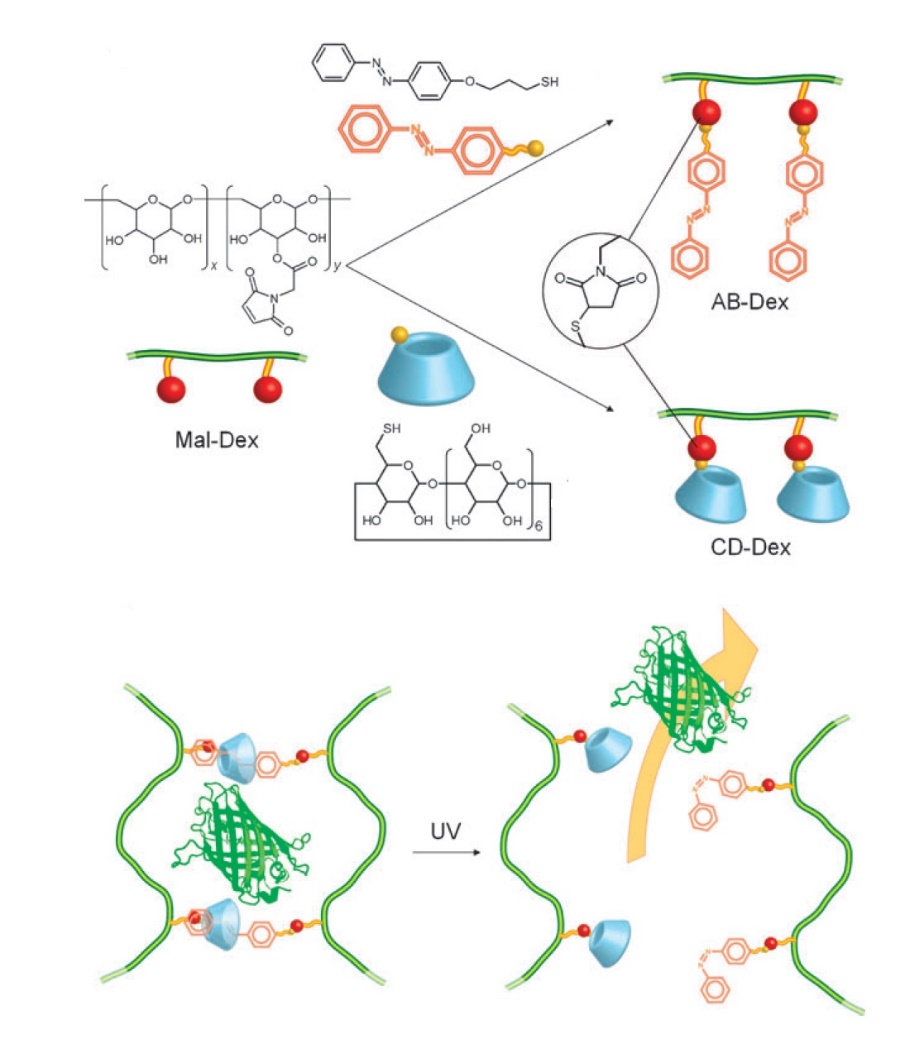Abstract
Tissue engineering is the use of combination of cells and materials by using engineering methods to replace or improve biological tissues. It involves the use of a scaffold which support the formation of a viable new tissue. Tissue repair and regeneration is one of the major challenges of these days. Polymer substrates are the main components in this tissue engineering. Polymer substrates provide the essential factors for physiological regeneration process. Polymer scaffolds are combination of polymers with, drugs, cells, can be used for therapeutic treatment of diseases and also for regeneration of several vital organs of human body such as ear, blood vessels, coronary artery etc. This report will focus on the different types of polymers used, their preparation methods, properties and their applications in tissue repair and regeneration. The combination of these polymer scaffolds with other advanced materials and their uses are evaluated. An overview on the latest technologies involving the new polymer materials used in the tissue engineering is also undertaken.
Contents
Biodegradable Polymer Scaffolds
Abstract
Tissue engineering is the use of combination of cells and materials by using engineering methods to replace or improve biological tissues. It involves the use of a scaffold which support the formation of a viable new tissue. Tissue repair and regeneration is one of the major challenges of these days. Polymer substrates are the main components in this tissue engineering. Polymer substrates provide the essential factors for physiological regeneration process. Polymer scaffolds are combination of polymers with, drugs, cells, can be used for therapeutic treatment of diseases and also for regeneration of several vital organs of human body such as ear, blood vessels, coronary artery etc. This report will focus on the different types of polymers used, their preparation methods, properties and their applications in tissue repair and regeneration. The combination of these polymer scaffolds with other advanced materials and their uses are evaluated. An overview on the latest technologies involving the new polymer materials used in the tissue engineering is also undertaken.
Tissue engineering or the Idea of replacing a tissue with another, dates back to early 16th century. The first published Tissue replacement was in 1597 by Gaparo Tagliacozzi, Professor of Surgery and Anatomy at the University of Bologna.1 Tissue repair and regeneration are different spontaneous natural healing processes that occur after an injury. In general, Liver is one of the organs in the human body that can regenerate after partial resection or necrosis.2 Gastrointestinal (GI) tract and the epithelia of the skin renew themselves and can regenerate themselves after an injury, as long as the stem cells of both these tissues are not destroyed.3
Tissue engineering applies methods from biology and engineering fields to create artificial constructs for regenerating of new tissue.4 Regeneration or growing a tissue can be done in two different ways. First approach is to isolate cells from a patient’s body and to grow them on a three dimensional scaffold under controlled conditions. The cultured tissue is then replaced with the defected or damaged tissue in the patient body and the scaffold is degraded over time.5 Second approach is to directly grow the tissue in vivo using scaffolds which stimulate and direct tissue growth.5 Second method is advantageous as it doesn’t require patient cells and also the growth of tissue takes place in situ. The combination of both the above mentioned methods is commonly referred to as tissue engineering triad (Fig.1).1 The complete schematic of the tissue engineering process done using in vitro method is shown below in Fig. 2.

Figure 1 Tissue Engineering Triad of cells.1

Figure 2 Schematic of In Vitro Tissue Cultivation and Transplantation
Tissue regeneration process typically involves three main elements which provides the essential factors for the entire process. The first component is substrate which has membranes, foams, meshes and 3D scaffolds. These components support the tissue by allowing cell migration from the host site to damaged or defected site and promote its growth. The second element is chemical signals they are generally Bone morphogenetic proteins (BMPs) or Vascular Endothelial growth factors (VEGF) or Insulin like growth factors (IGF) etc. These growth factors allow proliferation of cell to promote growth of new tissue. The last components are cells which can be undifferentiated or differentiated cells, generally stem cells which replicate themselves and induce tissue growth.
Scaffolds play important role in tissue engineering. Extensive research is carried out in this field from past two decades. Scaffolds are generally three-dimension porous biomaterials which provide support for tissue regeneration. Scaffolds are used to promote cell-biomaterial interactions, ECM deposition and cell adhesion. Scaffolds are highly porous materials due to this they are used for transport of gases, nutrients and other regulatory factors which promote tissue growth.6
Scaffolds can be produced from variety of materials and numerous techniques have been used to produce these scaffolds. Scaffolds should have below requirements in order to be suitable for use in tissue engineering.
The first patent for using scaffolds in tissue engineering was granted in 1977.7 Since then, polymers are widely used as biomaterials for developing medical devices and tissue engineering scaffolds.8
Polymer scaffolds play a major role in tissue engineering. Extra Cellular Matrix (ECM) of human body has variety of proteins, gels and polysaccharides which are combined to form a network that supports cells. Naturally derived polymers play a major role in tissue engineering scaffolds. Naturally derived polymers like collagen and gelatin are widely studied for using them as tissue engineered consturct.9 Natural polymers have complex structural composition this led to development of synthetic polymers. Synthetic polymers can be developed with controlled structural composition, they can be biodegradable and also functionalized for specific use. These advantages led to development of various Synthetic biodegradable polymers.10 This report gives information about various polymers used in tissue engineering.
Aliphatic polyesters are widely used in the tissue engineering as synthetic polymeric scaffolds. These polymers are linear hydro carbon chain molecules with oxygen bonds in between them. Aliphatic polyesters are highly stable porous materials. Polyesters usually doesn’t melt or dissolve during in vitro tissue regeneration process, this quality gives them advantage over other polymers.11 Polyester have ester groups, these esters groups helps them undergo degradation by hydrolysis. Major advantage of using them is their degradation rates can be tuned using their composition, molecular weight and structure.12 Polylactide (PLA) is an aliphatic polyester prepared from monomer lactide (Fig. 3). PLA is biodegradable and also widely used as a scaffold in tissue engineering. PLA scaffolds are hydrophobic due to repeating methyl groups present in its structure. PLA scaffolds mechanical integrity is very high and it can stay stable for months in both In vitro and In vivo studies.13 Polyglycolic acid is an aliphatic polyester prepared from monomer glycolic acid (Fig. 4). PGA is most commonly used material for polymer scaffolds. PGA is crystalline in nature and its mechanical integrity in a solution is about one month. PGA is one of the first developed synthetic polymeric scaffold and used as fibrous fabrics in tissue engineering.14 Poly(lactide-co-glycolide) (PLGA) is a polymer prepared by reacting lactide and glycolide in the presence of stanus octoate (Fig. 5). PLGA is combination of both PLA and PGA so it has similar characteristics of both of them. Degradability rate of PLGA is also in between PGA and PLA. Various ratios of PGA and PLA are used to synthesize PLGA polymers for different scaffold requirements.15 The above mentioned monomers are synthesized by ring-opening polymerization. PLA, PGA and PLGA are all FDA approved polymers and can be used for human medical device testing and implantable devices.

Figure 3 Polylactide Monomer11

Figure 4 Polyglycolic acid monomer11

Figure 5 PLGA Monomerization reaction
Polyurethanes are also widely used polymer scaffolds in tissue engineering. Polyurethanes are prepared by combining polyols and isocyanate monomers (Fig. 6). Polyurethane molecule has segmented block structure due to this feature these molecules are used in broad range of biomedical devices.16 Polyurethanes are popular biomaterials because of their versatility, biocompatibility, biodegradability and tunable mechanical properties.17 Polyurethanes are highly durable and tough materials and they are used to develop heart valves, prosthetics etc. In late 1900’s and early 21st century polyurethanes are extensively studied for their degradable properties and drug delivery kinetics.18 Polyurethanes prepared from amino acid derived isocyanates provide higher ability for proliferation and cell adhesion. As these polymers are derived from amino acids they do not show adverse effects when used in human body.19 Due to the above mentioned characteristics polyurethanes are widely used in tissue engineering as scaffolds.

Figure 6 Polyurethane Monomer
Extensive research is being carried for using other synthetic polymers as scaffolds in tissue engineering. Polyanhydrides, Polyphosphazenes, Polyethylene glycol and Polyglycerol sebacate (PGS) are some of the important synthetic polymers which are currently studied for using in tissue engineering scaffolds. PEG and PGS polymers are mainly studied for use in soft tissue engineering like blood vessels, cartilage and retina.2021
Synthetic polymers discussed above are biodegradable and easy to manufacture. But, they usually lack active sites for interaction with cells in the tissue. Monitoring of synthetic polymers also becomes hard as they lack active sites. To overcome these difficulties of these polymers Functional synthetic polymers are developed and used as scaffold molecules for tissue regeneration.
Conducting polymers are polymers which show similar electrical and optical properties as of semiconductor. These polymers are easy to synthesize and can be scaled up. Early researchers found out that conducting polymers can be used to modulate cell adhesion, proliferation and enhance electrical properties of the adhered cells.22 Many research studies are carried out in electrically sensitive tissues in the human body like bone, muscle, nerve and mesenchymal stem cells etc.23 Conducting polymers are usually functionalized synthetic polymers, so they are usually made by combining conducting materials with biodegradable materials. Polypyrrole (PPy) and Polyaniline (PANi) are the conducting polymers generally added to synthetic biodegradable polymers to increase electrical conductivity. PLA and PPy nanoparticles are mixed and polymerized using emulsion polymerization to obtain pyrrole PDLLA solution. This solution by precipitation gives conductive biodegradable material.24 PANi is also widely used in preparation of conducting polymer composites. PANi with Poly-lactide-caprolactane (PLCL) is a conductive polymeric scaffolds, which has high elasticity and electrospinning capacity which can be used to adhere to human dermal fibroblasts.25 However, conducting polymers mentioned above has poor degradability and biocompatibility as retaining conducting polymers may damage the tissue if they are not degraded. This led to development of degradable conducting polymers. Aniline oligomers are highly desirable and they have well defined structures, electrical activity similar to that of polyaniline. Aniline oligomers combined with PLA to form degradable electrically conducting polymers are shown below (Fig. 7).

Figure 7 Star Shaped, Hyper branched and Crosslinked PLA – Aniline oligomers
Functional polymers based on photo responsive characteristics drawn great interest in recent years. For example, recently scientists have found out that combination of Azobenzene (AB) and Cyclodextrin (CD) i.e. crosslinking both the AB and CD molecules, functionalized AB-Dex and CD-Dex are prepared which are used as release systems for proteins by irradiating UV-light on these molecules (Fig. 8).26

Figure 8 AB- Dex and CD – Dex protein release schematic
Tissue Engineering uses three-dimensional porous biomaterials or biodegradable polymers scaffolds. The main purpose of these scaffolds is to support the cells and allow mass transport. Mathematical or computational models can be applied to for the above mentioned process and to characterize scaffold morphology. Oxygen consumption, cell differentiation and mass transport of nutrient play a major role in tissue engineering. 27 Computational methods are widely used in tissue engineering field to predict the exact phenomena occurring inside the polymeric scaffolds.
You have to be 100% sure of the quality of your product to give a money-back guarantee. This describes us perfectly. Make sure that this guarantee is totally transparent.
Read moreEach paper is composed from scratch, according to your instructions. It is then checked by our plagiarism-detection software. There is no gap where plagiarism could squeeze in.
Read moreThanks to our free revisions, there is no way for you to be unsatisfied. We will work on your paper until you are completely happy with the result.
Read moreYour email is safe, as we store it according to international data protection rules. Your bank details are secure, as we use only reliable payment systems.
Read moreBy sending us your money, you buy the service we provide. Check out our terms and conditions if you prefer business talks to be laid out in official language.
Read more